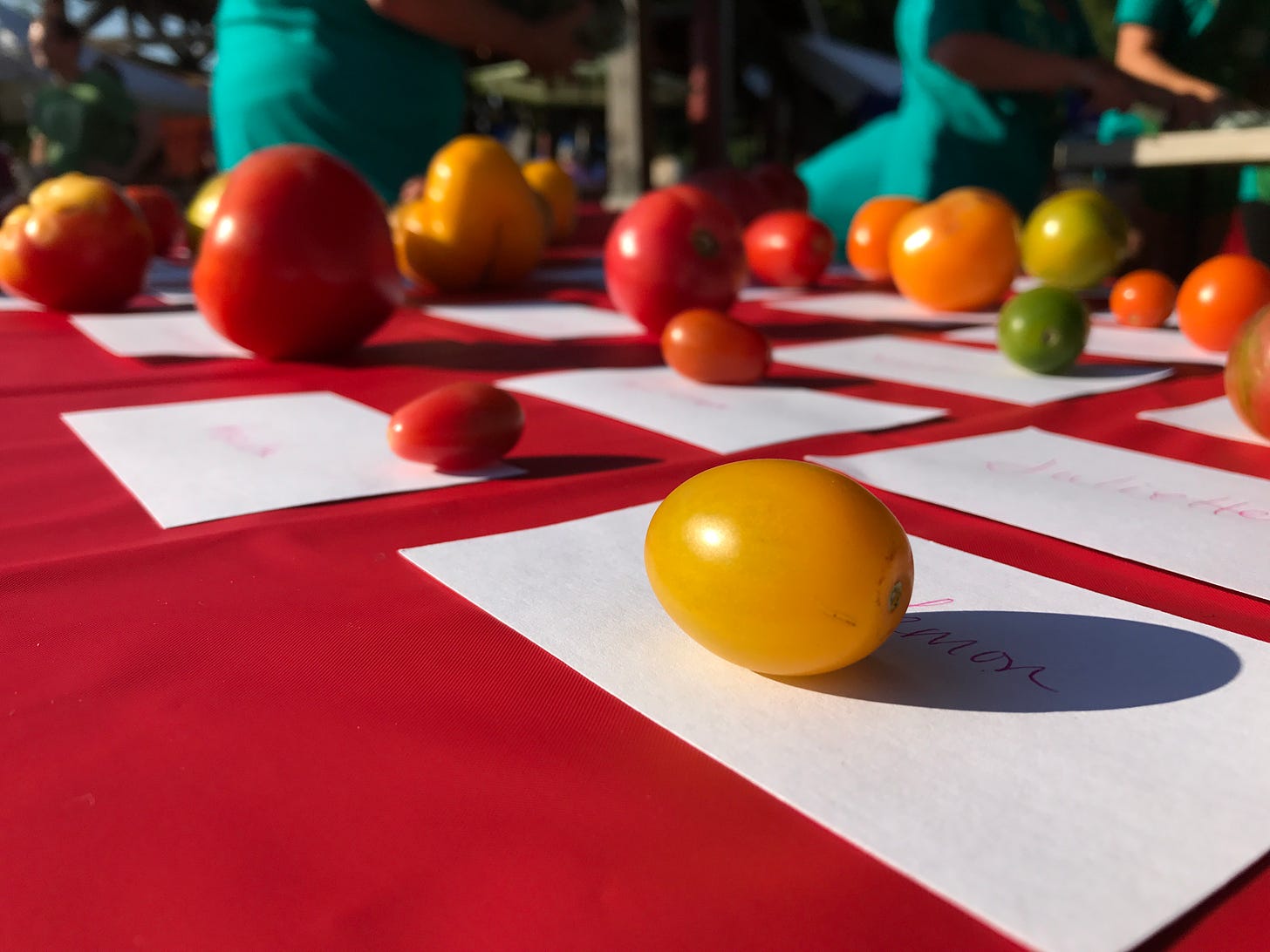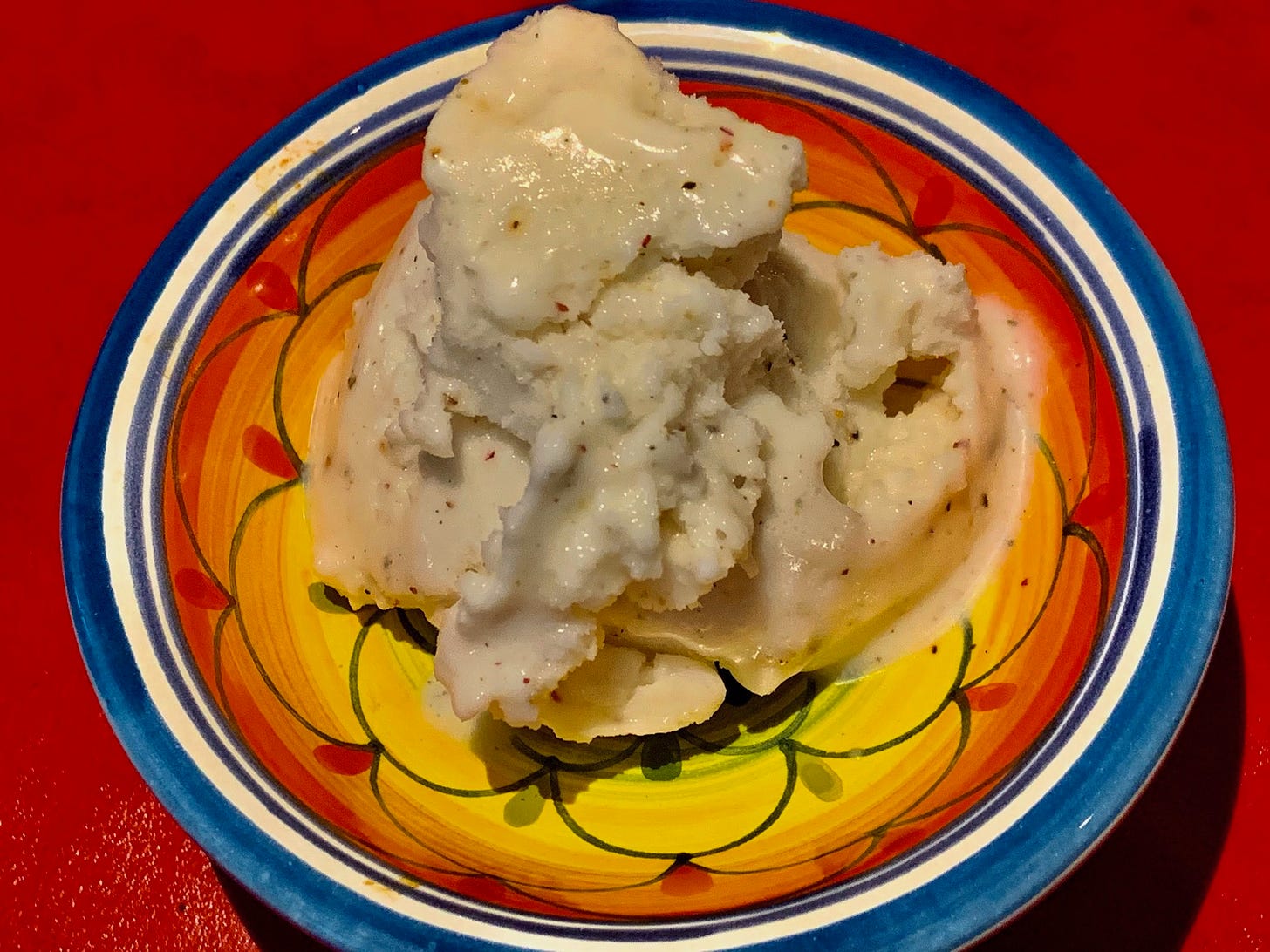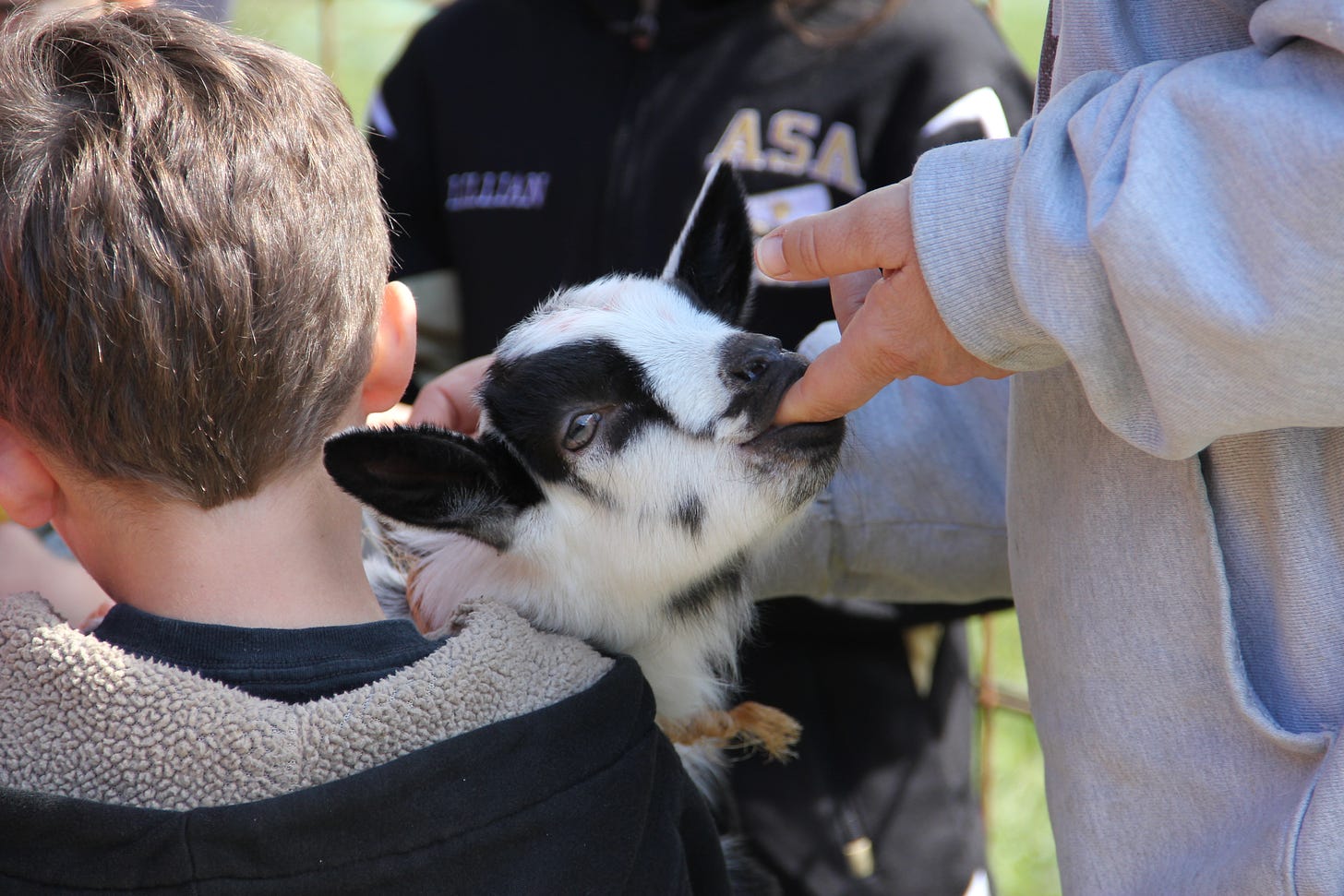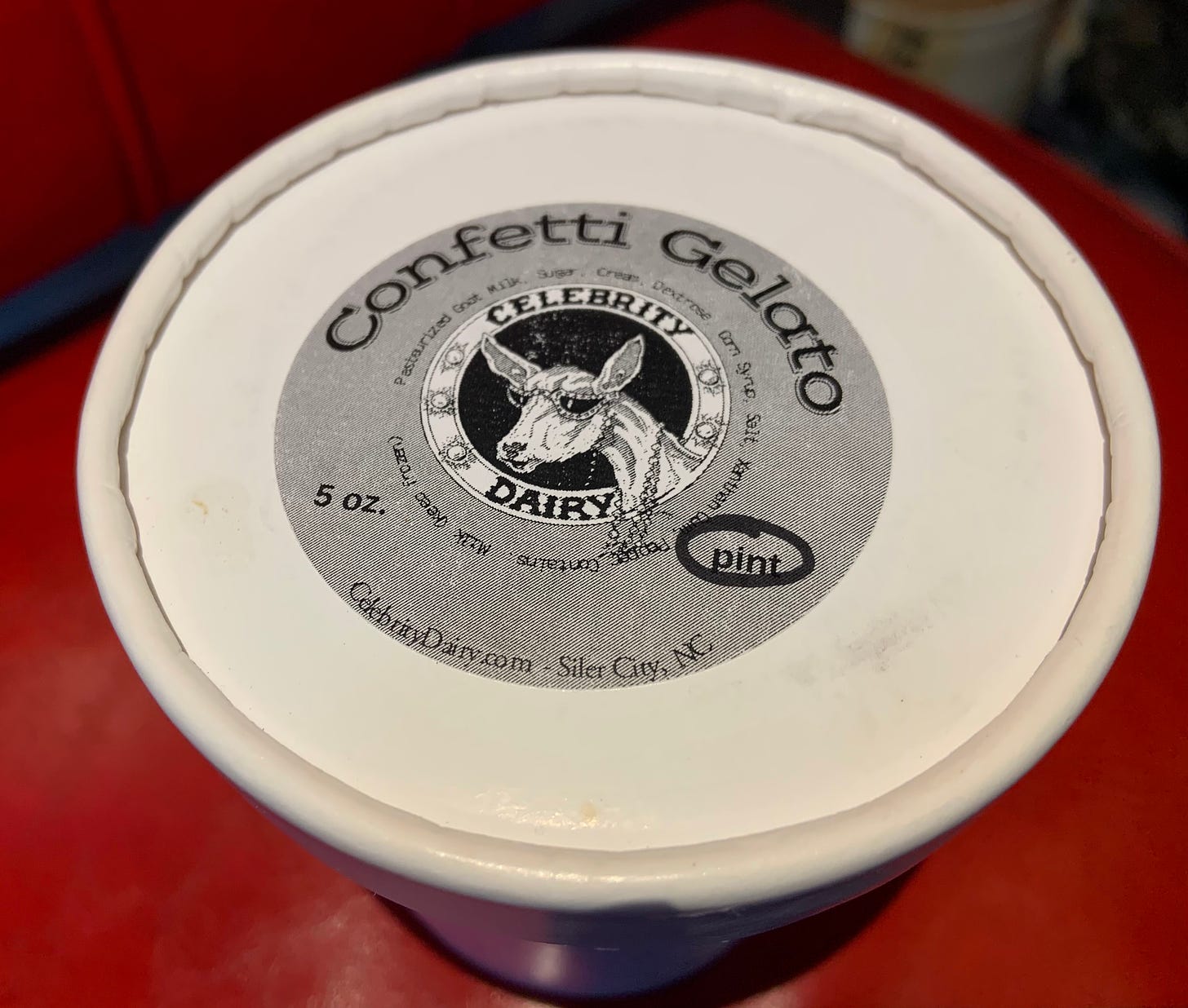It was July—Tomato Day at the Carrboro Farmer’s Market. It’s the biggest event of the year at one of North Carolina’s most celebrated organic markets. All of the tomato producers had set out free samples of heirlooms and hybrid favorites—red, yellow, purple, green--on tables in the gazebo at the center of the sprawling commons next to Town Hall.
Tomato Day at the Carrboro Farmer’s Market
A line of customers—bags of fresh produce hanging on their shoulders, some pushing strollers—had mysteriously assembled in a long line that curved around the outside of the gazebo and snaked far, far back toward the new playground. This was not the tomato line. A young man off to the side of the tomato tables was handing out samples of something else in tiny, tucked paper cups—the kind you might use to serve butter mints or distribute pills to hospital patients. We got in line without knowing what was being offered. It had to be something really good, given the crowd, but we couldn’t see what.
Slowly the line progressed, and as we drew closer, it began to feel like church, as if we were heading for a communion of some sort. People were quiet--solemn even—and very patient, preparing themselves by knitting their fingers together, ready to receive the gift. The young man was reciting a few muffled words to each supplicant ahead of us. But what?
When I reached him, I took a cup along with a pinky-sized bamboo spoon. I bowed my head. Softly, the young man said, peppercorn goat’s milk gelato as if it were a blessing. And then to the next pilgrim behind me, peppercorn goat’s milk gelato. It was not Latin; it was ice cream!
I stifled the urge to answer, “And peace be with you, too”
It was like haiku, but only nine syllables. How beautiful and creamy was the sample nesting in the cup and dotted with miniscule specks of pepper that had been cracked and stirred in—a savory surprise.
Confetti Gelato.
Suddenly, an edible memory from my teenage years hit me in that moment, so I must digress.
I was a child in Atlanta in the early 1960s, before the city had welcomed very many purveyors of international cuisine other than a few Chinese restaurants. But there was an authentic New York deli on a main thoroughfare where suburb met city on the north side. Two, identical flat-roofed buildings, made of glass and steel, sat side by side, rectangular islands in the parking lot of a shopping center. One was a drive-by liquor store, and the other was called Tri-Me Delicatessen, a name probably designed to encourage die-hard, meat-and-three Southerners to at least TRY the foreign fare.
Inside, the glass-front cases of meats and wheels of cheese, the long, fresh-baked batards jutting from baskets, the giant jars of pickles, and the cheese cakes were dazzling in the bright lights. The smells, too, were irresistible—steam from thick soups simmering and slabs of dripping beef roasting. A complicated menu hung above it all, but Tri-Me’s specialty sandwich was what they called Po’Boys—again probably the owners’ idea of what might sound more familiar to drawling Georgians than Hoagie, or Grinder, or Dagwood.
But these foot-long sandwiches, I would later learn, were not Po’Boys of the Louisiana genre. They were built of lapping layers of precision-sliced turkey, roast beef, mortadella, salami, and capicola, interrupted only by provolone and thin green panes of wet dill pickle. The foot-long rolls were not from New Orleans either, but made in house, always fresh, crunchy on the outside and spongey on the inside. I don’t know if it was their special brand of mayo, the homemade dills, the dark mustard, or the amazing combo thereof, but I have never since had a sandwich that I loved as much.
We’d ask the guy behind the counter to slice each sub into two-inch-thick rounds, which he’d wrap, still assembled as a sub, in slick white paper strapped shut with masking tape. We’d carry them, along with Cokes and chips, for sustenance on rafting trips down the Chattahoochee River or picnics in Chastain Park. Peppercorns studded the cured meats, which meant that a satisfying peppery schmeck came in nearly every bite and sometimes stuck in the teeth.
So, there I am standing beside the Farmer’s Market gazebo in Carrboro, licking the last of the sweet and not-at-all-goaty gelato on my bamboo spoon, and I am remembering those sandwiches—the delicatessen torn down fifty years—revived instantly by this lovely zip of peppercorn on the tongue.
Brit Pfann, co-owner with Fleming Pfann, of the Celebrity Dairy near Siler City, North Carolina, is the maker of the peppercorn gelato. The Celebrity goat herd is well known for its fine chèvre, also occasionally flavored with peppercorn in a Boursin rendition. The gelato, however, was a new experiment for Celebrity that year. So new that Britt had not brought any gelato to sell at the Market, only the cartons he’d donated to the Tomato festivities. After tasting the treat, shoppers had rushed to his booth for more and were sorely disappointed
One of the Celebrity kids at an Open Barn held in February.
Now we buy the stuff whenever Britt makes it available. These days, Celebrity calls it Confetti Gelato. It comes in pints and features a colorful combo of black, pink, white, and green peppercorns—tasty alongside pies—sweet or savory.
As I did a little more research, I found that the ice cream guru, David Lebovitz, author of The Perfect Scoop, offers a recipe for a custard-based ice cream that involves steeping warm milk, sugar, and peppercorns to create an infusion of peppery flavor. Only after straining out the whole peppercorns does he bring in the ice cream freezer. But another Lebovitz recipe calls for cracked peppercorns thrown into a chocolate ice cream mixture after it has begun to firm up. Either way, a trip to a good spice store will probably leave you reeling at the variety of peppercorns to try, but what a great excuse for a dessert party!
So, you may ask, why I am offering a story about ice cream during the coldest months of the year? February, as you may know, is the prime time for kidding—that is, the season when goats give birth to kids and milk production is plentiful, but I’d suggest we leave the production of goat’s milk gelato to Celebrity Dairy. They have it perfected.
Still, there’s a good chance, that you might have the ingredients to whip up some snow ice cream before winter is over. In which case, cracked peppercorns could be a special addition. In my 2018 book, The Month of Their Ripening, (which is coming out in paperback this fall), I offer the following tips, based on years of experience (with thanks to Donna Campbell) in the making of snow ice cream.
1) Make a simple syrup of equal parts of sugar and water. Heat to a simmer until the sugar dissolves. Put the syrup in the fridge to chill, even before the snow starts.
2) Use a cold metal bowl to collect clean snow after it has been coming down for a little while—place it outside on a table or other high place.
3) Mix the chilled simple syrup with heavy cream and a heavy splash of vanilla.
4) Bring in the snow when you have as much as you want and whisk the cream mixture into the snow frugally, adding cracked peppercorns. Stop when the texture is like ice cream. You can even make your own vanilla in advance by adding a vanilla bean—also from the spice store—to a small amount of whiskey or rum and let it get acquainted before the snow arrives.
Let me know how it goes!









Just when I thought winter might get my goat. :-)
Oh for goodness sake!! Let it snow, let it snow, let it snow!! Now I want Peppercorn and Crown Snow Cream. LOVE